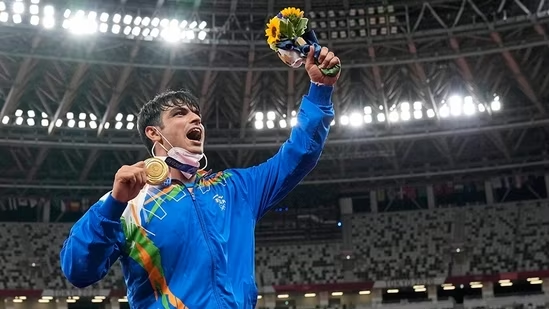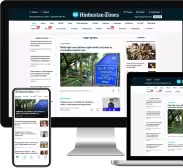The Neeraj Chopra effect, a year on from the historic Tokyo gold
As Neeraj Chopra's javelin sailed into the humid Tokyo night sky last year to the day, ending India's perennial wait for an athletics medal at the Olympics, 5,000 km away in Uttar Pradesh's Kushinagar, young Shivam Baranwal went berserk. In that seminal moment, the then 17-year-old discovered his life's purpose, or so he claims. “It had to be javelin,” he says a year on, ready to begin formal training in the event at the capital's Jawaharlal Nehru Stadium.  PREMIUM
PREMIUM
Baranwal had thrown the spear a few times for fun at school, but the javelin bug bit him in the run-up to the Games. On the day of Chopra's final, Baranwal's family was huddled in front of a projector installed in their living room. Chopra's 87.58m effort prompted them to feed the entire neighbourhood and the family burst crackers “worth ₹40,000”.
“A moment like that deserved a special celebration. I want to emulate Neeraj... his throwing technique, style, everything,” gushes the bespectacled teen. He even has a technical explanation for Chopra's silver-winning throw at the Eugene World Championships. “He could have touched 90 metres but his right ankle twisted a bit at the time of release which altered his throwing angle,” he explains.
Baranwal is not alone. Sachin Rajput, 21, turned up at the Nehru Stadium on the humid evening, making the 100-km trip from UP's Bulandshahar for javelin training. “I learned through social media that this place teaches javelin, so I just boarded a train,” he says.
The coaches at India’s largest athletic stadium claim the craze among amateurs is just the tip of the iceberg. The interest in javelin has gone up to such an extent since Chopra’s triumph but there are only so many aspirants that the coaches can accommodate.
“The interest is huge. Who would have thought that one man's genius can move the nation to such an extent?” says Vipin Kasana, a former India international turned coach. The 32-year-old represented India at the 2014 Glasgow and 2018 Gold Coast Commonwealth Games, where he was fifth.
Over the past year, Kasana has rejected close to 100 youngsters who approached him for training. He oversees about 40 trainees compared to hardly five a year back.
“I still get 5-7 requests every day. Sometimes people approach me via my seniors or colleagues, so it gets tricky to say no. It is really heartening to see the interest,” Kasana says.
The interest in javelin cuts across age and gender. Kids as young as six line up for javelin lessons with men in their mid 20s. Former national champion-turned-coach Sunil Goswami recalls turning back a 40-year-old.
“Sometimes, we have to tell the grown-ups point blank that your body is fully grown and it is impossible to pick up a sport at this age. We also have parents bringing their five-year-olds and demanding that we make them national champions,” says Goswami, whose son picked up javelin after watching Chopra competing in Tokyo.
Hammer throw coach Nirbhay Sharma's son Lakshya traded discus for the spear after watching Chopra's heroics and bagged silver at this year's Delhi State Athletics Championships.
“The real import of that gold will be visible by 2028 Olympics when you’ll have intense, high-quality competition from such youngsters,” says Goswami. “I am told in villages and hinterland young boys and girls are mad about javelin. Village kids have raw strength and are extremely driven, so the talent will not be in short supply. We certainly need more coaches to guide these kids properly,” Goswami adds.
Equipment makers are having a field day too. The likes of Vinex Enterprises and Amentum Sports are registering a bump in sales. Ashutosh Bhalla, Director at Vinex that supplies high-quality javelins to the Athletics Federation of India, says, “The numbers were really high in the few months just after the Games, but despite the sales stabilising a bit there has been a 10 % jump in javelin sales since last year."
Sidharth Patil, co-founder of Indore-based Amentum Sports, has registered a 90 % increase in sales post Chopra's gold. “We expect this percentage to go up considering the number of javelin events being held these days and the general interest among youngsters,” says Patil.
“To give you an idea, before Chopra's medal we sold 2-3 Nordic javelins a month. Post August 2021, we have been selling 6-7 spears, sometimes 10, a month. Each javelin costs around ₹1 lakh, so the buyers are obviously serious about the sport,” he says. The company has sold over 350 javelins since August last year, largely due to the Chopra effect.
Experience unrestricted digital access with HT Premium
Explore amazing offers on HT + Economist Start 14 Days Free Trial Already Subscribed? Sign In
Disclaimer: The copyright of this article belongs to the original author. Reposting this article is solely for the purpose of information dissemination and does not constitute any investment advice. If there is any infringement, please contact us immediately. We will make corrections or deletions as necessary. Thank you.







